Let's visit Yazd Water Museum which is located next to Amir Chakhmaq Complex.
.jpg)
Water Museum, Khane Kolahduzha
Going toward Qiam Street, we can get into the museum from its small door. Its building is one the unique buildings from Qajar dynasty named as Khane Kolahduzha or Kolahduzha's House.
The building with an area of 720 m2 was built 1266-1269 SH under the order of Seyed Ali Akbar Kolahduz who was a well-known business man who lived in this house with his wife, daughter, two sons and two families of his servants.
Once two qanats (Rahim Abad and Zarch) ran through the house. Zarch qanat is still running through it.
.jpg)
The Architecture of Water Museum in Yazd
The house was constructed in five floors. Passing the first floor, let's start visiting the house from the second floor which is a payab (water passage way). Let's enter the payab of Water Museum which is an octagon area with depth of 10 m. It has a stable favorable temperature which has been considered as an appropriate place for food storage. There is a pool in the center of the floor through which the water has been always running making the weather of the story cool and favorable.
.jpg)
Let's go toward the third floor. Let's pass through various corridors and rooms of this floor which consisted once a place for resistance of family members and now includes the main part of the museum. We can see different tools and instruments used for digging qanats, tools for measuring the volume of the water, tools for lightening qanats, water trade documents and old endowments, a handbook of Mirabs and water distribution documents, containers for storing and transporting water, and lots of other valuable things related to water.
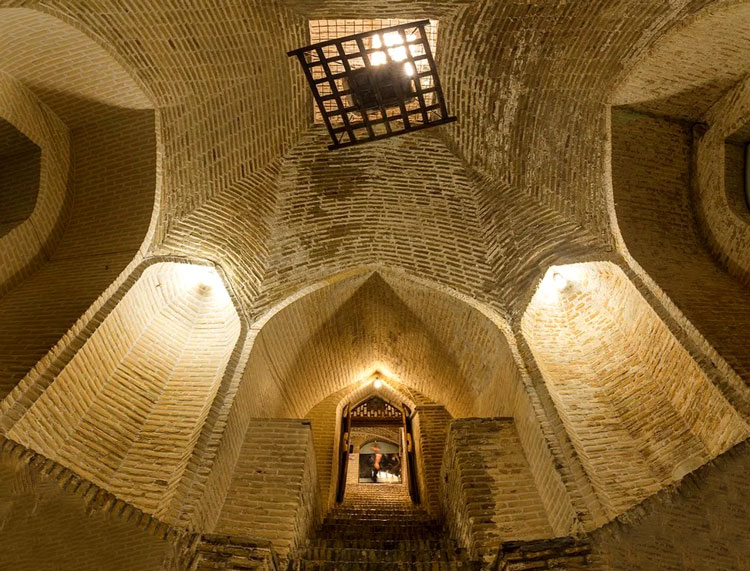
Then, let's move toward the fourth floor, the ground floor which we passed just entering the museum. The floor contained panjdaris, halls, rooms with sash windows, kitchens, and servant's rooms which we can visit one by one. Visiting this floor, we can see unique moldings which are known as plant designs with thin simgel (a combination of plaster and mud) background.
.jpg)
Why do pitmen wear white clothes?
As we can see in the museum, pitmen were used to wear white clothes when digging qanats. The reasons for this were first to make them able to see each other in the large wells and second these clothes could act as their shrouds.
We can also pay a look at the oldest water- clock which is 700 years old and held in the museum. The clock dates back to Seyed Rokandin period.
.jpg)
Mirror Hall of Water Museum
Mirror hall is the most beautiful part of Khane Kolahduzha that we can visit while appreciating the artist architecture creating such elegance.
Let's enter the document room to watch the documents carefully. It is interesting that in some documents, water was appointed as women's dower due to high value and importance of water in desert area. In some other documents, we can observe that some benevolent people donated some water shares to derelict women and orphans.
.jpg)
The roof of Water Museum of Yazd
Having visited the fourth floor, now let's get into the fifth floor which is the roof. Once there has been a well in this part of the house and two people were assigned to raise water from Rahim Abad qanat which ran through the house and store the raised water in the reservoir to provide the household water. Regarding this, it is said that the house has had water pipe system since 150 years ago.
.jpg)
Historical Objects in Yazd Water Museum
Visiting all the floors, we have seen over 200 historical tools and items related to water from digging qanat to some major documents of main qanats in Yazd. The tools that we can see include hacks special for digging qanats, windlasses, pitmen clothing, various faucets for getting water from water reservoirs, clay and glass containers for storing and transporting water, a series of water musk, a qanat water circulation model, and documents and endowments.
.jpg)
Visiting Hours of Water Museum
The museum is open from 8 a.m. to 7 p.m. and the ticket is IR 20,000 for Iranian visitors and IR 150,000 for foreigners.
.jpg)
For more information about Yazd Water Museum, please contact Raadina Online Support.
Online Support










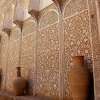
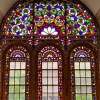
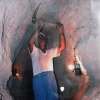
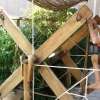
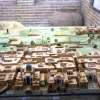
.jpg)
.jpg)
.jpg)

.jpg)
.jpg)
.jpg)
.jpg)
.jpg)
.jpg)
